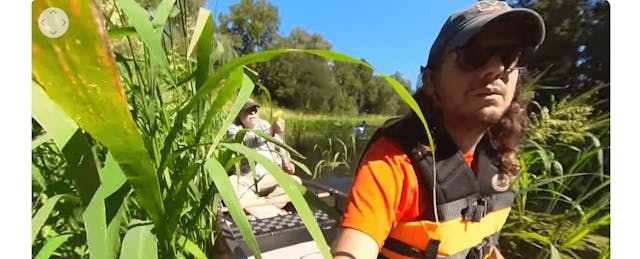Jared Ten Brink, a doctoral student in education at the University of Michigan, is an enrolled member of the Nottawaseppi Huron Band of the Potawatomi. He lives a two-and-a-half hour drive from the tribe’s reservation, which makes it hard for him to help his two young kids learn about their Native heritage.


As a former science teacher and instructional coach, though, he was looking for a way to deliver the teachings of tribal elders to a broader audience via distance education. But he wasn’t having much success using traditional streaming video.
“How do you really connect with the land when you're looking at this flat screen and a little box in Zoom?” he wondered. “How do you put somebody in that space?”
To help better preserve and share the teachings of his Native culture, he decided to try the latest in high tech tools — virtual reality.
But when he went to the tribal elders with the idea, not everyone was sold. Some were concerned that strapping on a VR headset would take students further from the natural world.
Other tribal leaders thought it was worth a try, though. So for the past year, Ten Brink has been trying the approach, taking a 360-degree camera out in the field to capture key cultural practices. The short VR videos are just part of a curriculum he’s developing, which also incorporates hands-on exercises as well.
Could virtual reality be the key to teaching indigenous ways of knowing to a broad population of students?
We connected with Ten Brink for this week’s EdSurge Podcast to dive into that question.
Listen to the episode on Apple Podcasts, Overcast, Spotify or wherever you listen to podcasts, or use the player on this page. Or read a partial transcript, edited for clarity, below.
EdSurge: How did this project come about?
Jared Ten Brink: As somebody who wasn't raised heavily immersed in my tribal culture, I don't really come at it from a place where I could do the teachings. Additionally, I'm not an elder. And so in my mindset, that's not my place. So I didn't want to be the one teaching on these videos. I wanted it to be somebody else.
So I connected with personal friends. I connected with tribal government connections and different organizations that I knew, and I asked them about this. And I sat down and said: What do you think of this idea? And what should we teach about? What should the topics be about for these?
We settled on two topics that are really significant to the Anishinaabe, the Council of Three Fires, that we’re part of: Maple sugar and manoomin, or wild rice.

Our ancestors were told to seek the place where food grows on the water. And they came down the St. Lawrence River and they found the place where food grows on the water, which is the Great Lakes basin where wild rice, manoomin, it grew everywhere. It was all over the place, and our story really closely mirrors the story of manoomin. As we were pushed out of our lands, manoomin was killed off. As settlers came, they filled in the wetlands where manoomin grew to grow potatoes, or they just killed it because they polluted the water systems. And so manoomin is now a threatened species.
Syrup is extremely important as well because syrup is how we survive the winter. Realistically, you get to February — this time of year — and your food supplies are running low, and that's right when the gift of syrup comes about. And we didn't just use it as syrup. We boiled it all the way down to make sugar. And it's great. Anybody can do it if you have a maple tree.
That's one of the things that we did with the kids. And it was so exciting to see. So we have these kids sitting here with these spoons, and they're stirring and stirring and stirring. And then all of a sudden, they're like, ‘Why is it changing color?’ After stirring for like five minutes, all of a sudden, in like 15 seconds, it goes from syrup to sugar. And they're like, ‘Whoa!’ It's so cool to see, and the kids thought it was so cool to see.
How does VR come in?
So for those videos, I went to a tribal member’s sugar bush in northern lower Michigan — so the northern part of the lower peninsula. We went out to the woods with a 360-degree camera, and I just followed him. We walked out into the woods. We tapped the first tree. He talked through the process and he taught me how to harvest maple syrup.
Some who hear about this idea might think it’s ironic that you’re using very modern VR tech to try to preserve an ancient culture.
I don't think it's ironic that technology helps us to learn in this space. Native people have utilized technology in a lot of different ways for a long time, and we're not stuck in one era or one past. And that was one of the things that I did talk about with some tribal members, though some tribal members were very adamant that they did not think this was appropriate.
Many more were in favor, of the ones I spoke to, and I'm sure there are plenty out there, and just like any other population. We don't all agree.
What do you see as the potential for VR beyond this project?
One of the potentials I see in the future is streaming VR, which would require a lot more resources than I have access to.
You know, if you can stream VR, then you can set up a camera around a sacred fire, and you can have a tribal elder teaching and talking to you on the land, and then you could be at your space with your peers, and have a sacred fire also burning and put your headset on, and connect to that person. One of the things I heard from a lot of Native people was, they missed the smell of the fire.
We did something where we had elders connect through Zoom. But it's not quite the same. When you're just looking at this call, you and I are in this box. You can't see the full space around you.
[In VR], you look around and you see people dancing around you. You see people watching, you see people talking — not everybody's doing the same thing. And there's so much more going on.


